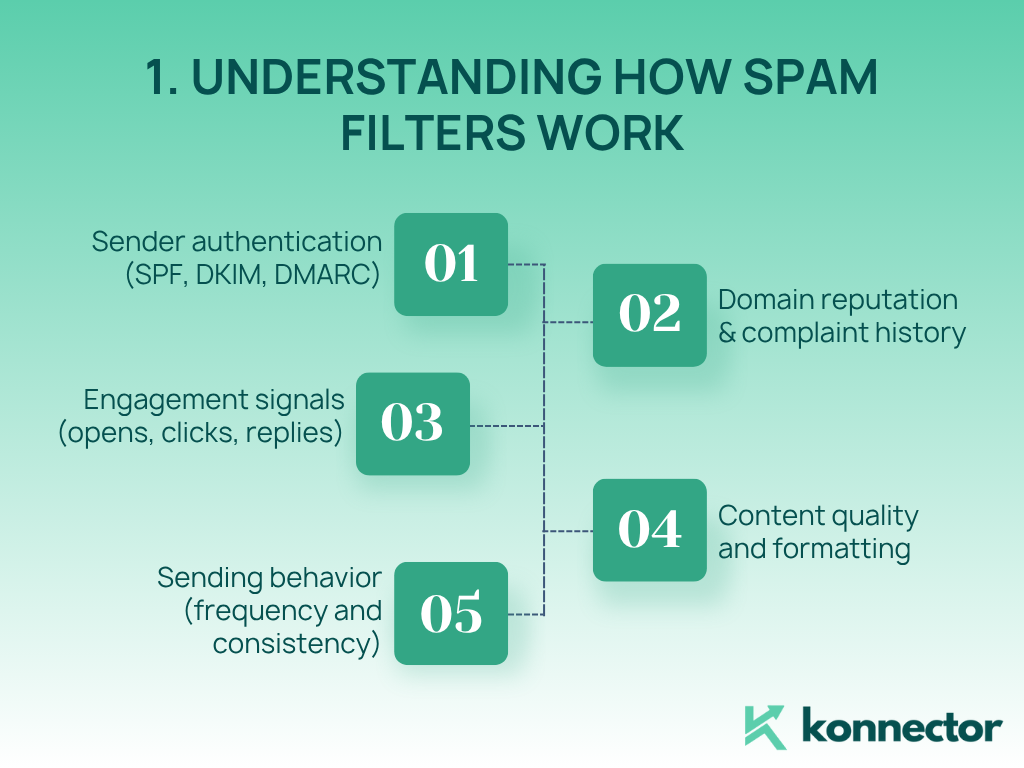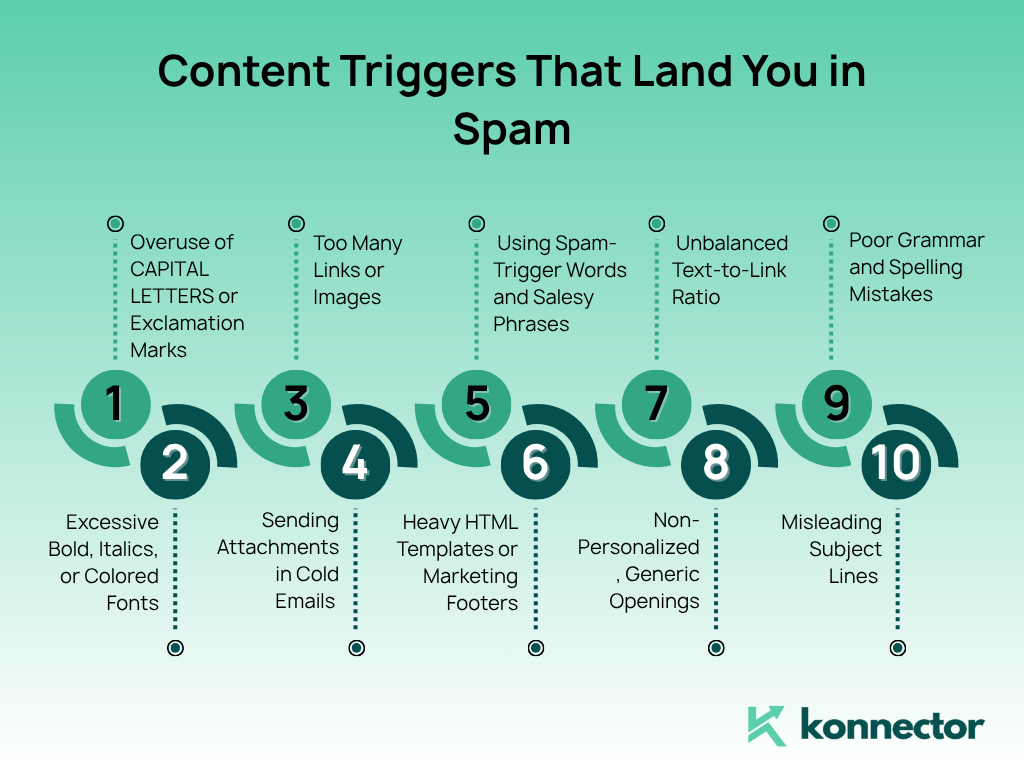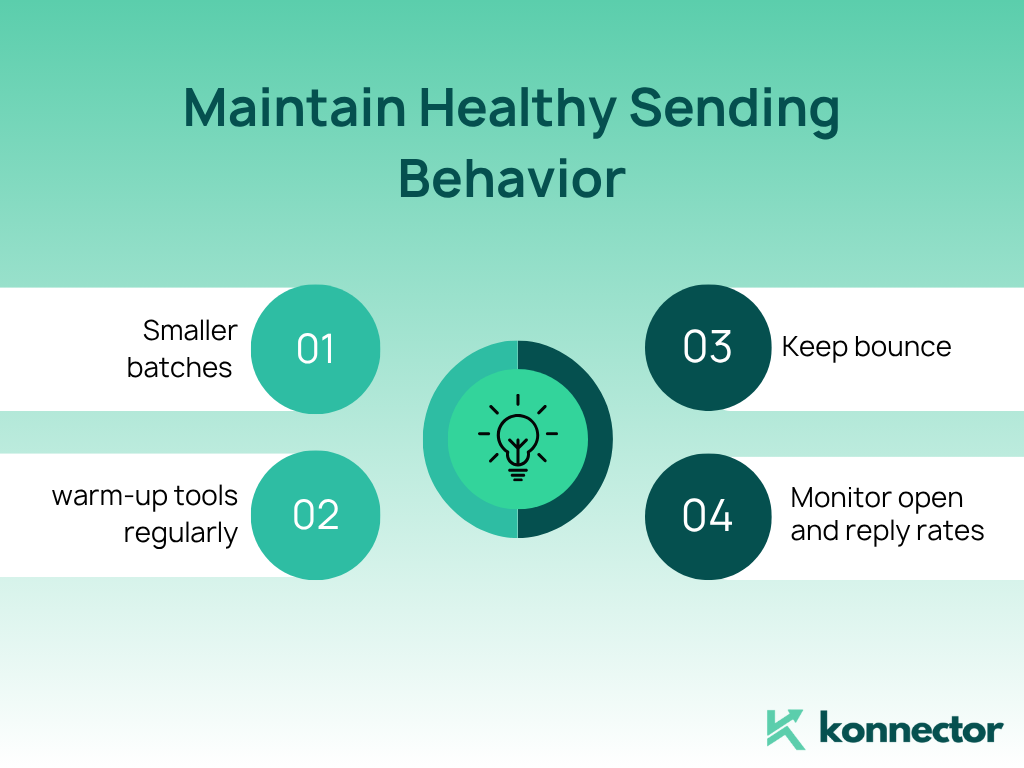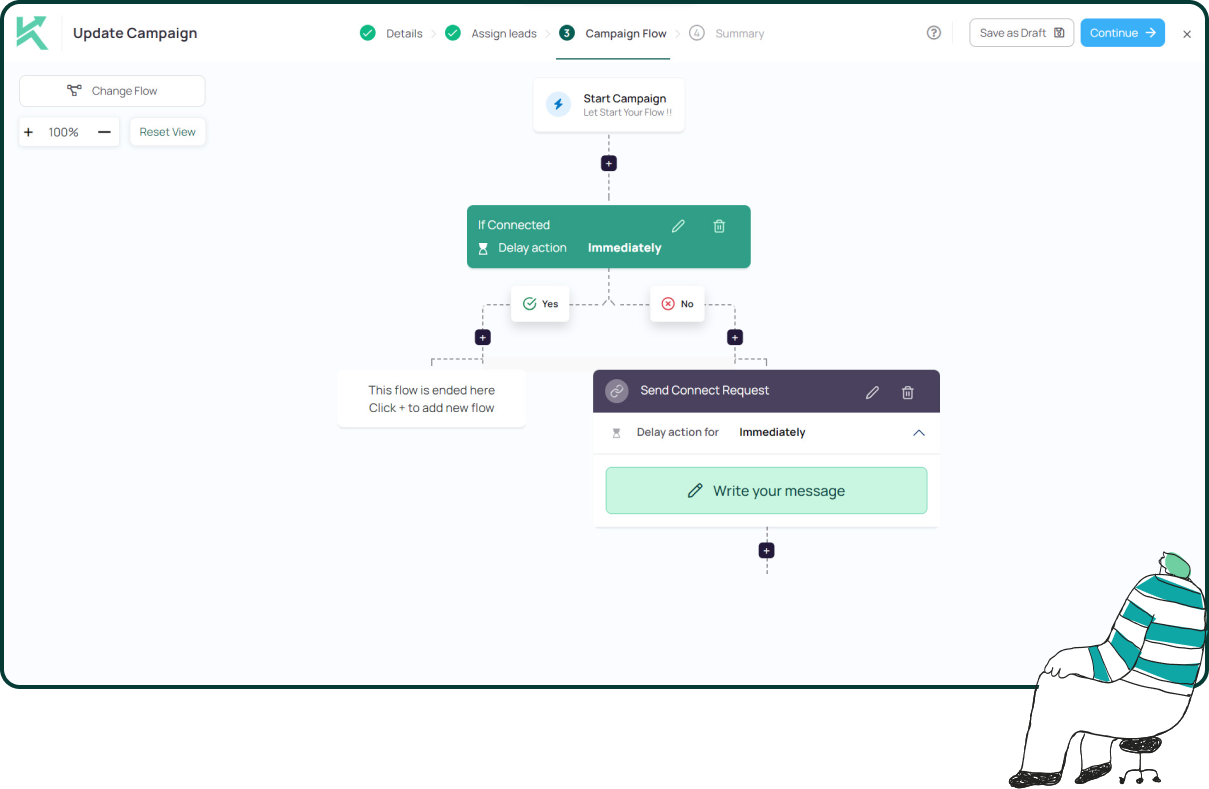Introduction: The Inbox Problem Every Marketer Faces
You’ve crafted the perfect outreach message, hit send… and silence.
Chances are, your email never reached your recipient’s inbox.
Every day, over 300 billion emails are sent — and spam filters have become extremely aggressive in filtering unwanted or suspicious messages.
This guide explains why your emails land in spam and what you can do to fix it permanently.
If you’re building a larger cold email strategy, start with our complete guide:
Cold Email Strategy: Your Action Plan to Connect with Sales Prospects
and pair it with the tech stack from
Best Email Deliverability Tools in 2026
to keep your emails consistently visible.
1. Understanding How Spam Filters Work
Spam filters analyze hundreds of data points to decide whether your email is “safe.”
They check:
- Sender authentication (SPF, DKIM, DMARC):
These authentication records verify that your emails are genuinely sent from your domain and not spoofed by hackers or spam bots.
Without proper authentication, even legitimate emails can be marked as suspicious and land in spam. - Domain reputation and complaint history:
Internet Service Providers (ISPs) monitor your domain’s trust level.
Frequent spam complaints, high bounce rates, or sudden spikes in send volume can hurt your reputation and reduce inbox placement. - Engagement signals (opens, clicks, replies):
Spam filters measure how recipients interact with your messages.
High engagement (opens and replies) indicates relevance, while low engagement suggests your content may be unwanted. - Content quality and formatting:
Emails with poor grammar, excessive links, or heavy HTML often resemble spam.
Keep your copy conversational, short, and cleanly formatted with minimal visuals for the best deliverability. - Sending behavior (frequency and consistency):
Inconsistent patterns — like sending 10 emails one day and 1,000 the next — can alarm filters.
Maintain a steady cadence and gradually scale volume, especially for new domains.

If any of these metrics look suspicious, your email is flagged as spam — even if it’s legitimate.
2. Common Reasons Your Emails Go to Spam
a) You’re sending from a new or unverified domain
Fresh domains without authentication (SPF/DKIM) look risky to mail servers.
b) Your email list isn’t clean
High bounce rates or sending to invalid addresses signal “spammy” behavior.
c) You’re using spam-trigger words
Phrases like “Free trial,” “Act now,” “Guaranteed results” often trigger filters.
d) You’re sending too many emails too fast
Sudden spikes in send volume can harm sender reputation.
e) Your recipients aren’t engaging
Low open or reply rates tell algorithms that people don’t value your content.
3. The Technical Fixes You Must Implement
These are your deliverability essentials — ignore them, and even great copy won’t help.
- Authenticate your domain
Set up SPF, DKIM, and DMARC records to verify you’re a legitimate sender. - Warm up your inbox
Before large sends, slowly build volume using tools like Warmy.io or Mailreach. - Verify every email address
Use tools such as NeverBounce to reduce bounce rates below 3%. - Use a custom tracking domain
Avoid generic tracking links — they’re red flags for filters. - Keep sending consistent
Regular cadence beats sudden bulk sending.
4. Content Triggers That Land You in Spam
Even the most authenticated sender can get trapped in spam filters if their email content looks promotional or artificial. Spam algorithms have become smarter — they now scan tone, formatting, and structure as indicators of authenticity.
Here’s what commonly triggers those filters and how to fix each one:
1. Overuse of CAPITAL LETTERS or Exclamation Marks
Emails written in all caps (like “ACT NOW!” or “LIMITED OFFER!!!”) instantly appear aggressive and promotional to filters.
Fix: Keep your tone calm and professional. Use sentence case, and save emphasis for a single phrase — not the whole email.
2. Excessive Bold, Italics, or Colored Fonts
Over-formatting screams “marketing blast.” Filters associate colorful or flashy text with bulk promotional campaigns.
Fix: Stick to a clean, plain-text layout with minimal styling. It feels more personal and performs better in B2B cold outreach.
3. Too Many Links or Images
Multiple links or embedded images can signal spam — especially if your link domain differs from your sender domain. Each link increases the risk of being flagged.
Fix: Limit to one trusted link (like your company website or meeting scheduler). Avoid image-heavy designs and use descriptive anchor text instead of raw URLs.
4. Sending Attachments in Cold Emails
Attachments (.pdf, .docx, .zip) are often flagged as potential malware, especially from unknown senders.
Fix: Never attach files in the first message. Instead, use a cloud-based link (Google Drive, Notion, or your company resource hub) with clear permission settings.
5. Using Spam-Trigger Words and Salesy Phrases
Spam filters rely on keyword libraries — words like “Free,” “Win,” “Act now,” “Discount,” and “Buy today” are immediate red flags.
Fix: Replace these with natural language alternatives.
Example: Instead of “Buy now for 50% off,” try “Here’s a simple way to save time and cost on your outreach.”
6. Heavy HTML Templates or Marketing Footers
Complex HTML code, banners, or unsubscribe blocks make your message look like a bulk newsletter.
Fix: For cold outreach, always use light HTML or plain text. Keep your email looking like a real one-to-one message.
7. Unbalanced Text-to-Link Ratio
When links dominate the body or the message feels like a “click funnel,” filters classify it as low-value.
Fix: Maintain a healthy ratio — about 90% text, 10% links. Always provide context before inserting any link.
8. Non-Personalized, Generic Openings
“Dear Sir/Madam” or “To whom it may concern” are dead giveaways of mass emailing.
Fix: Personalize your first line with a name, role, or company reference. Filters — and people — reward authenticity.
9. Poor Grammar and Spelling Mistakes
Low-quality writing is a top indicator of spam and phishing attempts.
Fix: Run every email through Grammarly or Hemingway before sending. Clean, well-written emails improve both readability and credibility.
10. Misleading Subject Lines
If your subject promises one thing and your email says another, recipients are likely to mark it as spam — hurting your sender score.
Fix: Keep your subject relevant, short (under 45 characters), and aligned with your message content.

Pro Tip:
Before launching any campaign, test your content with spam-detection tools like MailTester or GlockApps. If your spam score is below 8/10, tweak your copy, remove excess links, and simplify formatting.
See examples in our cold email strategy guide for better tone and structure.
5. Maintain Healthy Sending Behavior
Mailbox providers reward consistent, trustworthy senders.
To build that trust:
- Send smaller batches of personalized emails daily
- Use warm-up tools regularly (see Best Email Deliverability Tools in 2026)
- Keep bounce and unsubscribe rates minimal
- Monitor open and reply rates — tweak subject lines if engagement dips

6. Engagement: The Hidden Metric Filters Love
The more people open, reply, or click your emails, the more inbox providers trust you.
To improve engagement:
- Personalize your opening line and subject
- Keep your copy short and relevant
- A/B test different CTAs
- Follow up strategically (see our 14-day cold email follow-up plan)
7. Test Before Sending
Before launching a campaign, always test for spam triggers.
Tools like GlockApps, MailTester, and SendForensics can show whether your email is inbox-ready.
If your score is below 8/10, adjust your content and authentication before you hit send.
8. Ongoing Monitoring and Reputation Management
Email deliverability isn’t a one-time fix — it’s a continuous process.
Use tools that:
- Alert you when your domain or IP gets blacklisted
- Provide weekly reputation reports
- Analyze inbox placement trends
You’ll find detailed platform comparisons in our review:
Best Email Deliverability Tools in 2026
Conclusion: Stay in the Inbox, Not the Spam Box
Landing in spam doesn’t mean your outreach is bad — it means your setup needs tuning.
Focus on the three essentials:
Authenticate → Personalize → Monitor.
With the right habits and tools, you can fix deliverability issues within weeks and keep your email campaigns performing at their peak.
To take your outreach to the next level:
- Read Cold Email Strategy: Your Action Plan to Connect with Sales Prospects
- Explore Best Email Deliverability Tools in 2026

11x Your LinkedIn Outreach With
Automation and Gen AI
Harness the power of LinkedIn Automation and Gen AI to amplify your reach like never before. Engage thousands of leads weekly with AI-driven comments and targeted campaigns—all from one lead-gen powerhouse platform.
Frequently Asked Questions
Your emails may land in spam because of poor sender reputation, unverified domains, spam-triggering words, or inconsistent sending behavior. Filters also penalize low engagement — if people don’t open or reply, you’ll slowly get flagged as untrustworthy.
Authenticate your domain (SPF, DKIM, DMARC), warm up your inbox, clean your contact list, and send smaller batches daily. Also, personalize your content and avoid spammy formatting or attachments.
For a step-by-step outreach system, see Cold Email Strategy: Your Action Plan to Connect with Sales Prospects.
Avoid salesy or trigger phrases like “Free,” “Act now,” “Win big,” “Limited offer,” and “Buy today.” Replace them with value-based, natural alternatives such as “Here’s a quick way to save time” or “I’d love to share an idea.”
Yes. Too many links (especially to untrusted or mismatched domains) raise red flags. Keep a 90% text–10% link ratio and ensure links are from your verified company domain.
They can. Heavy HTML code or image-based emails appear promotional. For cold outreach, keep your design simple and text-based. Light HTML or plain-text emails perform better in deliverability tests.
SPF, DKIM, and DMARC records prove your emails are sent from a legitimate domain. They signal to mailbox providers that you’re a verified sender — significantly improving inbox placement.
You can monitor your sender reputation and blacklist status using tools like MailFlow, SendForensics, or GlockApps. For tool comparisons, see Best Email Deliverability Tools in 2026.
Gmail and Outlook use engagement-based filters. If recipients rarely open or reply, your messages get deprioritized. Improve personalization, vary subject lines, and send follow-ups that feel conversational.
Usually 2–4 weeks. With steady inbox warm-up, consistent sending, and clean data, your domain reputation can recover. Avoid sending high volumes while repairing your score.





